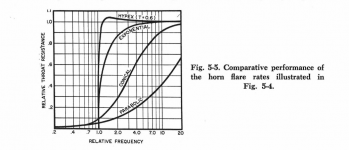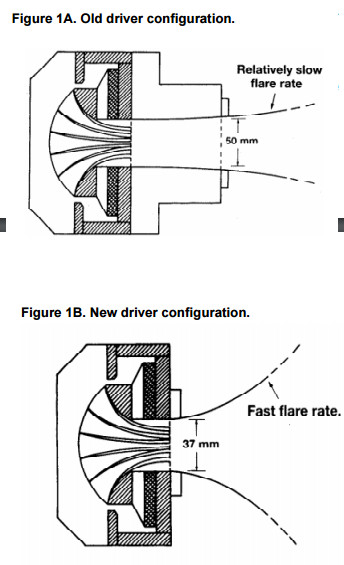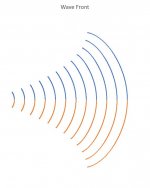Hey, what a surprise...
Chassis:
Cone:
Chassis:
An externally hosted image should be here but it was not working when we last tested it.
Cone:
An externally hosted image should be here but it was not working when we last tested it.
while we are on the topic can I ask one more question:
I often see flare rate specified as a frequency, ostensibly the cut off frequency of a horn with that flare rate. Is there a mathematical formula for this or is it just a heuristic?
Chapter 5 of this is the best info I've stumbled on re flare rate / cut off.
How To Build Speaker Enclosures By Alexix Badmaieff & Don Davis : Free Download, Borrow, and Streaming : Internet Archive
To me it is.
I've not seen or heard this one but i did with it's predecessor with a 12" carbon Davis and the th-4001/cd4001 combo.
They used to have a mtm 15"/th4003 copy/CD4003 with fully engraved/cnc ed front face which was impressive looking.
Never heard it.
Jmf designed the amplifiers for Kinoshita. When Tad stopped produce the horn the french importator got in touch with JMF to build replica as he was in touch with Kinoshita himself and probably had acces to some modifications he did to the tad original designas he did for his Rey audio and Rm range (JMF are located in the east of France where there is lot of forest and woodworking culture, at first they are electronic product specialist, working for french army amongst others...) and then loudspeakers appeared iirc.
Kinoshita use the Davis 12" in Warps.
Davis is located 3hour drive away from the area and they are open to custom designed speakers products hence partnership ( beside the quality of products). Phl is good too in France...
I've not seen or heard this one but i did with it's predecessor with a 12" carbon Davis and the th-4001/cd4001 combo.
They used to have a mtm 15"/th4003 copy/CD4003 with fully engraved/cnc ed front face which was impressive looking.
Never heard it.
Jmf designed the amplifiers for Kinoshita. When Tad stopped produce the horn the french importator got in touch with JMF to build replica as he was in touch with Kinoshita himself and probably had acces to some modifications he did to the tad original designas he did for his Rey audio and Rm range (JMF are located in the east of France where there is lot of forest and woodworking culture, at first they are electronic product specialist, working for french army amongst others...) and then loudspeakers appeared iirc.
Kinoshita use the Davis 12" in Warps.
Davis is located 3hour drive away from the area and they are open to custom designed speakers products hence partnership ( beside the quality of products). Phl is good too in France...
Last edited:
Sure, the curvature effects the area expansion, although less than the starting area for determining rate of expansion
If using area expansion as the definition of flare rate:
Isn't the highest flare rate at the throat where curvature is lowest?
And the lowest flare rate at the mouth where curvature is highest?
I think this is why I get confused when flare rate is interchangeably used to describe both area expansion and curvature...since high and low descriptors get swapped...
You're correct, the flare rate depends on the horn's flare type (its mathematical curve).
A tractrix has a lower flare rate at the throat and much higher towards the mouth. This is why people often prefer tractrix to exponential, because the latter doesn't open up to the same extent (the flare aka the curve is exponential).
It's confusing.
In my previous post I zoomed in on the OS throat section.
Last edited:
To me it is.
I've not seen or heard this one but i did with it's predecessor with a 12" carbon Davis and the th-4001/cd4001 combo.
They used to have a mtm 15"/th4003 copy/CD4003 with fully engraved/cnc ed front face which was impressive looking.
Never heard it.
Jmf designed the amplifiers for Kinoshita. When Tad stopped produce the horn the french importator got in touch with JMF to build replica as he was in touch with Kinoshita himself and probably had acces to some modifications he did to the tad original designas he did for his Rey audio and Rm range (JMF are located in the east of France where there is lot of forest and woodworking culture, at first they are electronic product specialist, working for french army amongst others...) and then loudspeakers appeared iirc.
Kinoshita use the Davis 12" in Warps.
Davis is located 3hour drive away from the area and they are open to custom designed speakers products hence partnership ( beside the quality of products). Phl is good too in France...
Good info here!
This is the MTM, I suppose?
Yes it is. This one was/is active filtered iirc.Basically an RM 8 with different drivers.
Ever seen the JMF amps? Such beasts... they delivers lots of current to drive the RM! They were mandatory if you wanted an Hidley's room...with a pair of Kinoshita! Not bad testimony of quality from the Westlake owner...
The one i liked the most was based around the same Davis 15" carbon as the Jmf in the picture but with a 'clone', of TH ( without the fins thoug) and a 2450. It was a diy effort.
Ever seen the JMF amps? Such beasts... they delivers lots of current to drive the RM! They were mandatory if you wanted an Hidley's room...with a pair of Kinoshita! Not bad testimony of quality from the Westlake owner...
The one i liked the most was based around the same Davis 15" carbon as the Jmf in the picture but with a 'clone', of TH ( without the fins thoug) and a 2450. It was a diy effort.
Last edited:
Krivium, a relatively easy to build diy Synergy/MEH for domestic use, would (in my mind) consist of a DCX464, BMS coax, HF1440 or another comp. driver that goes down to 500-600Hz + 2x10" or 2x12".
Tom Danley acknowledged (somewhere) this could work.
Apparently, Joseph Crowe is working on a 'finless' Yuichi/TAD style 300Hz horn.
For those not familar with TAD horns, those are abbreviated to TH and not to be confused with Tapped Horns.
I've never seen JMF amps in real life.
Tom Danley acknowledged (somewhere) this could work.
Apparently, Joseph Crowe is working on a 'finless' Yuichi/TAD style 300Hz horn.
For those not familar with TAD horns, those are abbreviated to TH and not to be confused with Tapped Horns.
I've never seen JMF amps in real life.
Last edited:
Those JMF are definitely sexy. But there is a French carpenter building bespoke cabinets that look even better to my taste:
http://www.alg-audiodesign.com/wp-content/uploads/2014/02/HR2-03-01.jpg
I own two Davis drivers BTW but the building quality of those is not convincing.
Regards
Charles
http://www.alg-audiodesign.com/wp-content/uploads/2014/02/HR2-03-01.jpg
I own two Davis drivers BTW but the building quality of those is not convincing.
Regards
Charles
I am starting to get confused myself...
If we consider the curves in the plot below to be representive of "Flare Rate", then for the exponential it's nearly constant (very low) at low frequencies, increases in the midrange and decreases above 7kHz.
It's still confusing, because this plot shows flare rate versus throat resistance across the frequency range.
If we consider the curves in the plot below to be representive of "Flare Rate", then for the exponential it's nearly constant (very low) at low frequencies, increases in the midrange and decreases above 7kHz.
It's still confusing, because this plot shows flare rate versus throat resistance across the frequency range.
Attachments
Last edited:
Those JMF are definitely sexy. But there is a French carpenter building bespoke cabinets that look even better to my taste:
http://www.alg-audiodesign.com/wp-content/uploads/2014/02/HR2-03-01.jpg
I own two Davis drivers BTW but the building quality of those is not convincing.
Regards
Charles
Agreed Charles, on both statements.
I've come across more than a few complaints as regards the quality of Davis drivers and I like the ALGs as well.
I could definitely live with JMF HPM500, provided those ridiculous 'devil's ears' and 'smiley mouth' around the woofer were exhanged for decent looking ports.

Yes Alg does some very nice drawing but i've never seen one build. It should exist but as long as i've not seen it.. they remains nice drawing/3d rendering.
I don't know all the Davis line, mainly the carbon ones. From 8"cm to 15" i think i've heard most of them. I really like them, they have a very nice low end ( the 8" i thought was incredible given the size). One pro loudspeaker builder using them told me they have difficult break up which need to be adressed.
About quality i don't know, never heard complaints about this particular ones.
Which one do you own Charles? And Ro808 about which ones have you heard bad things?
It seems we are unlucky with our french's drivers company: Phl are really difficults to obtain and have reliable data, Davis could be unreliable, Cabasse or Focal won't sell drivers... To bad there is some true gems in there!
Ro808: the loudspeaker you describe is not very different from Weltersys's Syntrip in my view. I hope Danley will make a 'serious' studio monitor ( a half beast inclined to high sound quality rather than spl )
But yes this is something i would be very interested to listen at. There is something about point source, HE, multiway and controled directivity i find appealing. Fit nicely my own preference.
I don't know all the Davis line, mainly the carbon ones. From 8"cm to 15" i think i've heard most of them. I really like them, they have a very nice low end ( the 8" i thought was incredible given the size). One pro loudspeaker builder using them told me they have difficult break up which need to be adressed.
About quality i don't know, never heard complaints about this particular ones.
Which one do you own Charles? And Ro808 about which ones have you heard bad things?
It seems we are unlucky with our french's drivers company: Phl are really difficults to obtain and have reliable data, Davis could be unreliable, Cabasse or Focal won't sell drivers... To bad there is some true gems in there!
Ro808: the loudspeaker you describe is not very different from Weltersys's Syntrip in my view. I hope Danley will make a 'serious' studio monitor ( a half beast inclined to high sound quality rather than spl )
But yes this is something i would be very interested to listen at. There is something about point source, HE, multiway and controled directivity i find appealing. Fit nicely my own preference.
Last edited:
I have no experience with Davis drivers, but heard and read some stories about quality issues in the past. Perhaps they've improved their QC eversince.
Their drivers look nice on paper and the reviews on TLHP are generally positive.
The MEH/Synergy in my description is similar to the SynTripP, but even more to Peter Morris' mid/high.
With the crossover at 500 or 600Hz, the MEH probably wouldn't withstand prolonged extreme SPL though.
However, at home 110dB is already earblisteringly loud.
Their drivers look nice on paper and the reviews on TLHP are generally positive.
The MEH/Synergy in my description is similar to the SynTripP, but even more to Peter Morris' mid/high.
With the crossover at 500 or 600Hz, the MEH probably wouldn't withstand prolonged extreme SPL though.
However, at home 110dB is already earblisteringly loud.
Last edited:
High Flare Rate Waveguide:
Attachments
Last edited:
Agreed. Syntripp, P. MORRIS's design and Danley products are the 3 most interesting design in PA for years in my view.
Mark100 is lucky to have 2 of the 3.
Mark100 is lucky to have 2 of the 3.
An interesting modern horn is the 1.4" one from Ciare:
http://oem.ciare.com/pdf_oriz_3.php?info=450
It basically opens up conically in the horizontal axis. And in the vertical axis it opens such that the area follows a hyperbolic rule. It is constant directivity in the horizontal plane and narrowing in the vertical - like the radials do. I have never herad it though. One interesting thing is that its entry angle is the same as the Radian 745's exit angle.
A disadvantage is the narrow beamwidth.
Regards
Charles
I've never seen any of those 'being used' either.
A bunch of the appurtenant drivers - FMJ - 60 "Daisy" - were recently offered at 50€ each.

Last edited:
Due to the short throat there's hardly any loading of the driver below, say 800-1000Hz.
Is this problematic? Dr. Geddes doesn't think so, but I would still be interested in a "1P to the power of 1.4" OS throat 😀
The "loading" - as much as I dislike that word - depends on the angle of the OS waveguide as well as its radius. Hence, for a 90 degree 1" waveguide the radiation resistance is falling below about 500 Hz. A narrower angle lowers the cutoff as does a wider throat radius.
These differ considerably from horn theory.
And no, I do not see any issues with loading from an OS waveguide. As I have said many many times before, this "loading", from the waveguide is insignificant in the bigger picture.
Hi Earl,
I've got a question to you, maybe a bit off topic maybe not... could it be possible to have a coax with an OS profile/shape? Like a 15" Tannoy but with a membrane following OS profile.
If heavily filtered around 300hz to reduce intermodulation distortion it could give interesting results.
I've got a question to you, maybe a bit off topic maybe not... could it be possible to have a coax with an OS profile/shape? Like a 15" Tannoy but with a membrane following OS profile.
If heavily filtered around 300hz to reduce intermodulation distortion it could give interesting results.
Last edited:
High Flare Rate Waveguide:
Your drawing of the wavefronts cannot be correct. For it to be correct, the wave would have to move faster at the center than at the edge - not possible.
In fact, it turns out that the true wavefront (not one drawn by hand) cannot have a curvature whose center moves past the origin (thoat) - it can be behind the throat, but not in front of it, i.e. the wave can be flatter, but not more curved than it is at the source.
Hi Earl,
I've got a question to you, maybe a bit off topic maybe not... could it be possible to have a coax with an OS profile/shape? Like a 15".
If heavily filtered around 300hz to reduce intermodulation distortion it could give interesting results.
It could, but as with all waveguide, it wants to be as large as the woofer, which means that it would have to obstruct the woofer. If you mean using the cone as the waveguide, this could be done, but then I don't know what effect a moving waveguide contour would be, but it is probably not a good idea.
I never worry about "intermodulation" distortion in any loudspeaker (except very poorly designed ones.) It's simply not a significant effect.
Waveguides do "distort", but in a linear way, through diffraction, (but not nonlinearly.) That's why diffraction is a bad thing. It can get quite perceptible at higher SPLs.
- Home
- Loudspeakers
- Multi-Way
- Is it possible to cover the whole spectrum, high SPL, low distortion with a 2-way?




